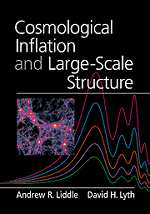Book contents
- Frontmatter
- Contents
- Frequently used symbols
- Preface
- 1 INTRODUCTION
- 2 THE HOT BIG BANG COSMOLOGY
- 3 INFLATION
- 4 SIMPLEST MODEL FOR THE ORIGIN OF STRUCTURE I
- 5 SIMPLEST MODEL FOR THE ORIGIN OF STRUCTURE II
- 6 EXTENSIONS TO THE SIMPLEST MODEL
- 7 SCALAR FIELDS AND THE VACUUM FLUCTUATION
- 8 BUILDING AND TESTING MODELS OF INFLATION
- 9 THE COSMIC MICROWAVE BACKGROUND
- 10 GALAXY MOTIONS AND CLUSTERING
- 11 THE QUASI-LINEAR REGIME
- 12 PUTTING OBSERVATIONS TOGETHER
- 13 OUTLOOK FOR THE FUTURE
- 14 ADVANCED TOPIC: COSMOLOGICAL PERTURBATION THEORY
- 15 ADVANCED TOPIC: DIFFUSION AND FREESTREAMING
- Appendix: Constants and parameters
- Numerical solutions and hints for selected examples
- References
- Index
10 - GALAXY MOTIONS AND CLUSTERING
Published online by Cambridge University Press: 05 June 2012
- Frontmatter
- Contents
- Frequently used symbols
- Preface
- 1 INTRODUCTION
- 2 THE HOT BIG BANG COSMOLOGY
- 3 INFLATION
- 4 SIMPLEST MODEL FOR THE ORIGIN OF STRUCTURE I
- 5 SIMPLEST MODEL FOR THE ORIGIN OF STRUCTURE II
- 6 EXTENSIONS TO THE SIMPLEST MODEL
- 7 SCALAR FIELDS AND THE VACUUM FLUCTUATION
- 8 BUILDING AND TESTING MODELS OF INFLATION
- 9 THE COSMIC MICROWAVE BACKGROUND
- 10 GALAXY MOTIONS AND CLUSTERING
- 11 THE QUASI-LINEAR REGIME
- 12 PUTTING OBSERVATIONS TOGETHER
- 13 OUTLOOK FOR THE FUTURE
- 14 ADVANCED TOPIC: COSMOLOGICAL PERTURBATION THEORY
- 15 ADVANCED TOPIC: DIFFUSION AND FREESTREAMING
- Appendix: Constants and parameters
- Numerical solutions and hints for selected examples
- References
- Index
Summary
The clustering of galaxies
Overview
The developing understanding of the galaxy correlation function has played a pivotal role in guiding research in large-scale structure for decades. Early work involved the cataloguing of galaxy positions on the sky, which revealed a complex pattern of clustering, which motivated the early work on structure formation. Obtaining galaxy positions is a relatively easy observational task, and this strategy has continued to be popular; for example, the APM galaxy survey (Maddox et al. 1990, 1991) compiled using an automatic plate measuring device, played a crucial role in the downfall of the Standard Cold Dark Matter (SCDM) model. A positional catalogue is also an important part of the forthcoming Sloan Digital Sky Survey (SDSS; Loveday and Pier 1998; Margon 1998).
Such catalogues contain millions of galaxies, which accounts for their power in testing cosmological models. Also, despite their two-dimensional nature, they can be used to say something about the clustering of galaxies in three dimensions, provided that we make the normal assumption of statistical isotropy of the clustering pattern and the plausible assumption that the probability distribution for the brightness of a galaxy is independent of its position (to prevent the catalogue from becoming distorted near its magnitude limits). Then the angular correlation function can be deconvolved to give the full three-dimensional correlation function, via an equation known as Limber's equation. However, the angular correlation function cannot be used to say anything about the actual clustering pattern, only about its statistical properties, and even for them the numerical inversion problem is a difficult one.
Information
- Type
- Chapter
- Information
- Cosmological Inflation and Large-Scale Structure , pp. 262 - 276Publisher: Cambridge University PressPrint publication year: 2000
